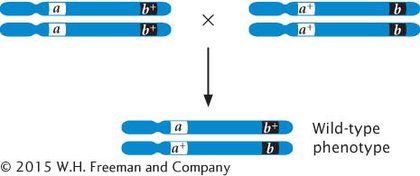Complementation: Determining Whether Mutations Are at the Same Locus or at Different Loci
How do we know whether different mutations that affect a characteristic occur at the same locus (are allelic) or occur at different loci? In fruit flies, for example, white is an X-
To carry out a complementation test on recessive mutations, parents that are homozygous for different mutations are crossed, producing offspring that are heterozygous. If the mutations are allelic (occur at the same locus), then the heterozygous offspring have only mutant alleles (a b) and exhibit a mutant phenotype:

If, on the other hand, the mutations occur at different loci, each of the homozygous parents possesses wild-

Complementation has taken place if an individual possessing two recessive mutations has a wild-
When the complementation test is applied to white and apricot mutations, all the heterozygous offspring have light-
CONCEPTS
A complementation test is used to determine whether two mutations occur at the same locus (are allelic) or at different loci.